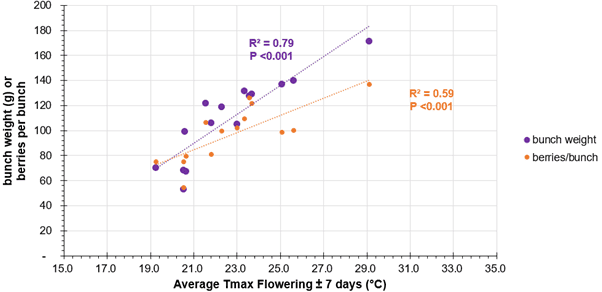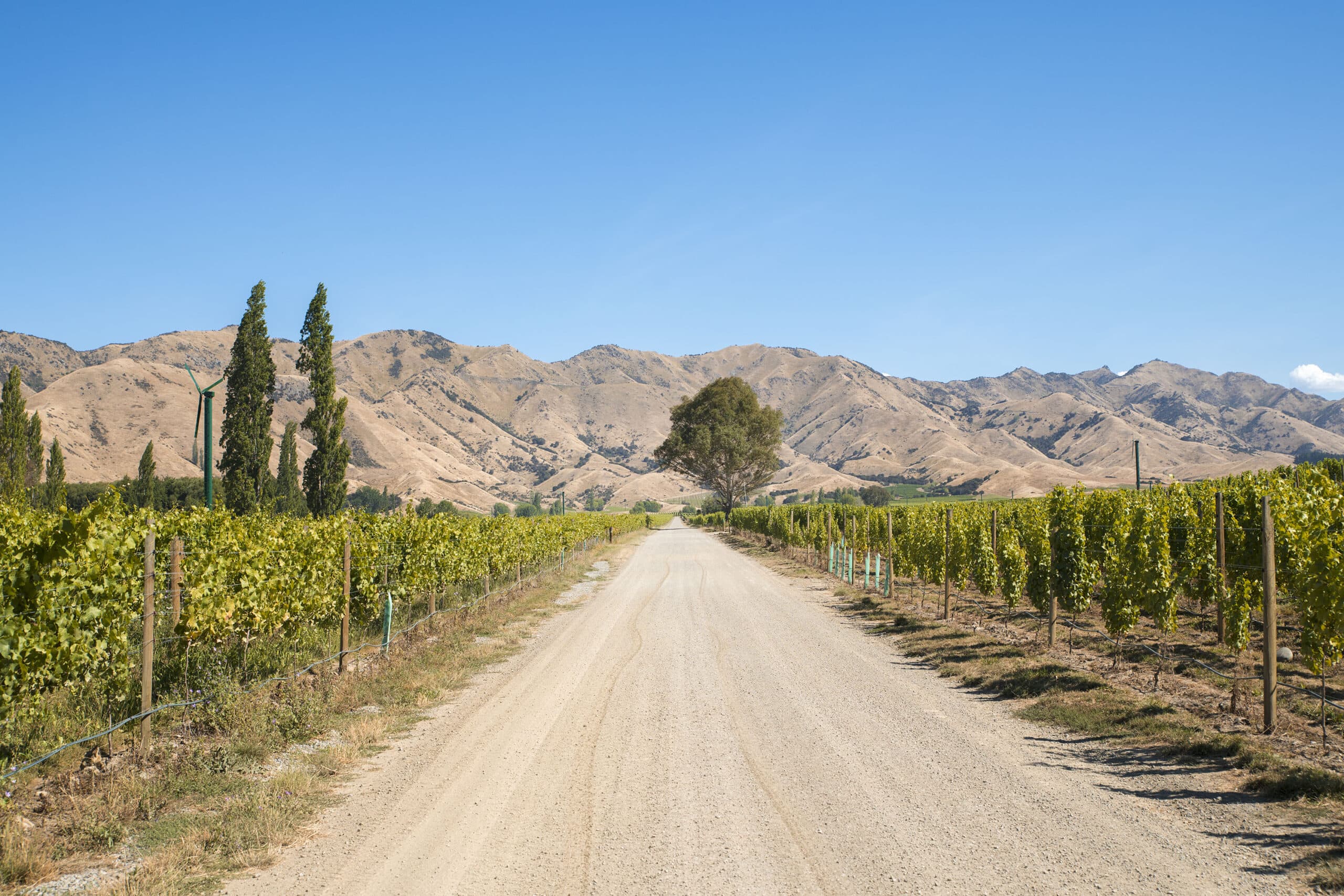Martin D, Grab F, Scofield C, Schurmann M, Stuart L, Grose C, Plant & Food Research
Since the initiation of the Pinot Noir Programme in January 2018, we have established a network of 12 trial sites in three New Zealand regions in a search to find individual vines that produced acceptable commercial yields (above 1.75 kg per metre of row) and wines of composition comparable to that of wines made with ‘Icon’ vines.
Five seasons of study have shown that berry weight is the dominant factor driving changes in berry, juice and wine composition. As the berry size decreases, there is a proportional increase in marc:wine ratio that in turn leads to a correlated increase in wine colour density and total phenolics. Smaller berries also have higher colour and phenolic content per unit area of skin. The effect of berry weight on composition is stronger than that of vintage, which in turn is stronger than yield, vineyard or region effects.
What does the international literature say about berry size and vine water deficits?
Soil water content and consequent vine water status has been extensively shown to strongly influence yield, berry size, fruit composition and overall wine quality. Vine water deficits lead to smaller berries and changes in fruit and wine composition. In Pinot noir, leaf water potential and surface soil water content have shown relationships with yield components (berry weight, cluster number and yield) but not with vine size. Higher (less negative) leaf water potential, and therefore lower water stress in the vines, related directly to larger berries but without associating directly with higher yields in all cases. Smaller Pinot noir berries had more anthocyanins, phenols and higher total soluble solids.
The effect of water stress on Pinot noir vines has also been tested using carbon isotope discrimination testing (δ13C) of juice and wine because photosynthates from water-stressed vines have relatively more 13C than 12C which results in a less negative C isotope ratio. Findings have shown volatile compounds such as higher alcohols and acetic acid were generally more abundant in wines from mild to severe water-stressed treatments. This effect was more evident when irrigation restrictions were accompanied by hot and dry summers. A moderate water stress in Pinot noir vines has also been shown to result in more complex and structured Pinot noir wine than those from well-watered vines.
Research in California has shown that a harvest juice δ13C value more negative than -27‰ corresponds with a mean seasonal stem water potential above -1.0 MPa, indicative of no (or very weak) vine water stress. It has also been shown that juice and wine carbon isotope ratios are well correlated to each other and to leaf water potentials for a given variety.
Berry weight differences were not always related to vine water status
All the vineyards in our ‘Ideal vine’ study had drip irrigation installed and very few vines in the overall population displayed visible water-deficit symptoms in the dry 2019, 2020 and 2021 vintages. Carbon isotope testing of the wines carried out in 2018, 2019 and 2021 showed only minor differences in overall seasonal vine water status (Figure 1). Regression plots show negative linear relationships between δ13C and berry weight that are season dependent. The slopes of the regressions are similar between vintages but the berry weight is offset, suggesting that something other than vine water status was having an effect on berry size. For a (well-watered) δ13C greater than -27 ‰, the predicted mean berry weight of the overall study population was approximately 1.4 g in 2018, 1.2 g in 2021 and 1.0 g in 2019. Figure 1 also suggests a tipping point at a δ13C above -27‰ where berry weight is reduced as vine water deficit increases. Less than 10 % of the wines had a δ13C in the range of -26‰ to -24‰, which is considered the weak to moderate water stress range. While very short-term vine water deficits that reduced berry weight and increased berry skin colour cannot be completely ruled out, it seems unlikely that the entire study network of 12 vineyards would be concurrently affected in a similar way.
Figure 1. Relationships between wine carbon isotope discrimination ratio δ13C:12C and berry weight for the New Zealand Pinot noir Ideal vine study network in vintages 2018, 2019 and 2021. The dotted blue line at δ13C:12C of -27‰ represents a probable water deficit threshold.
What caused season and vineyard related differences in berry weight?
While vine water status is often the primary cause of reduced berry size, other seasonal factors can affect berry growth. For example, weather conditions during early berry development, leaf area at flowering or nitrogen supply between fruitset and véraison. In our study, bunch weights for Pinot noir Abel clone and, to a slightly lesser extent, berry number per bunch, were highly correlated to the mean maximum temperatures (Tmax) experienced 7 days either side of mid-flowering (Figure 2). Berry size was also significantly but less well correlated to the flowering period Tmax (R2 = 0.48; P <0.001). Across the country and seasons higher temperatures during the flowering period consistently led to a proportional increase in bunch weight from more and larger berries.

Figure 2. Relationship between the average maximum air temperature (Tmax) during the 7 days either side of mid-flowering and the average annual regional bunch weight (purple dots) and the berry number per bunch (orange dots) for Pinot noir Abel clone.
Take-home messages
Smaller berries have higher colour and phenolic content per unit area of skin and proportionally higher marc:wine ratio that results in greatly increased Pinot noir wine colour density and total phenolics. The majority of vines in the Ideal vine study population did not experience water deficits which might otherwise account for differences in berry weight from year to year.
In New Zealand conditions, maximum temperature during flowering was a good predictor of Pinot noir (Abel clone) bunch and berry weight. It should, therefore, be possible to predict smaller and larger berried years from flowering weather data. Early warning of potential deficiencies in berry phenolic content would provide opportunities to implement targeted management techniques.
Manual green thinning should be used as a tool to reduce variation in bunch phenology and ensure a correct balance between leaf area and yield, but typically will not reduce berry size. Early leaf plucking will increase berry skin tannin, while mechanical shaking and deficit irrigation will more effectively reduce berry size than crop thinning.
Opportunities also exist to manipulate the marc:wine ratio in the winery through sorting and “saignée” techniques. Within the wider Pinot Noir Programme, our work provides hints that faster (active) sugar ripening paired with extended (passive) hang-time may also generate increases in the quantity and especially quality of berry phenolics, but solid proof remains elusive…
Acknowledgements
The authors would like to thank the 11 participating wine companies for providing the study vineyards and grape samples. This type of research is made possible by the intellectual contributions and passion of winemakers and viticulturists. For more information about the programme and these research aims, including full reports on methods used, please visit the members’ section of nzwine.com.


















